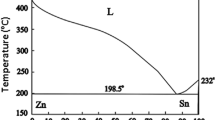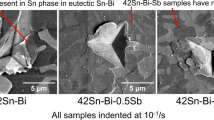Abstract
The deformation behavior of materials that exhibit a ductile-to-brittle transition have traditionally been characterized ex-situ and limited to bulk samples. Here, we use a unique experimental setup to perform in-situ cryogenic mechanical testing of Sn 96 solder alloy in a clamped beam configuration at − 142 °C, well below the alloy’s DBTT. Electron backscattered diffraction analysis before and after the in-situ experiments showed how deformation ahead of the crack tip is accommodated by the Sn matrix or intermetallic phase particles. Similar to behavior observed in pure Sn, within the Sn matrix of the Sn 96 alloy deformation twinning is the primary deformation mechanism below the DBTT. Similar to the twins previously observed in pure Sn, twinning behavior in the Sn matrix is consistent with the formation of the {301} and {101} twins in Sn. Within the intermetallic phase in Sn96, slip steps were observed that were not observed prior to bending.
Graphic abstract









Similar content being viewed by others
Data availability
The datasets supporting the conclusions of this article are included within the article and available upon request from the authors.
References
A. Lupinacci et al., Cryogenic in-situ microcompression testing of Sn. Acta Mater. 78, 56–64 (2014)
K. Lambrinou et al., A novel mechanism of embrittlement affecting the impact reliability of tin-based lead-free solder joints. J. Electron. Mater. 38, 1881–1895 (2009)
P. Darbandi, T.R. Bieler, F. Pourboghrat, T. Lee, Crystal plasticity finite-element analysis of deformation behavior in multiple-grained lead-free solder joints. J. Electron. Mater. 42, 201–214 (2012)
N.S. Brar, W.R. Tyson, Elastic and plastic anisotropy of white tin. Can. J. Phys. 50, 2257–2264 (1972)
B. Chalmers, The twinning of single crystals of tin. Proc. Phys. Soc. 47, 733–746 (1935)
K.N. Tu, D. Turnbull, Direct observation of twinning in Tin Lamellae. Acta Metall. 18, 915–929 (1970)
P. Ratchev, B. Vandevelde, B. Verlinden, B. Allaert, D. Werkhoven, Brittle to ductile fracture transition in bulk Pb-free solders. IEEE Trans. Components Packag. Technol. 30, 416–423 (2007)
P. Zhang, A. Xue, J. Wang, New challenges of miniaturization of eleectronic devices: electronmigration and thermomigration in lead free solder joints. Mater. Des. 192, 108726 (2020)
M.A. Fazal, N.K. Liyana, S. Rubaiee, A. Anas, A critical review on performance, microstructure and corrosion resistance of Pb-free solders. Measurement 134, 897–907 (2018)
H. Kotadia, P.D. Howes, S.H. Mannan, A review: on the development of low melting temperature Pb-free solders. Microelectron. Reliab. 54, 1253–1273 (2014)
B.N. Jaya, V. Jayaram, S.K. Biswas, A new method for fracture toughness determination of graded (Pt, Ni)Al bond coats by microbeam bend tests. Philos. Mag. 92, 3326–3345 (2012)
Y.W. Mai, A.G. Atkins, Crack stability in toughness testing. J. Strain Anal. 15, 63–74 (1980)
B.N. Jaya, V. Jayaram, Crack stability in edge-notched clamped beam specimens: modeling and experiments. Int. J. Fract. 188(2), 213–228 (2014)
B.N. Jaya, C. Kirchlechner, G. Dehm, Can microscale fracture tests provide reliable fracture toughness values? A case study in silicon. J. Mater. Res. 30(5), 686–698 (2015)
B. Jaya, N. Bhowmick, S.S. Asif, O. Warren, V. Jayaram, Optimisation of clamped beam geometry for fracture toughness testing of micron-scale samples. Philos. Mag. 95(16–18), 1945–1966 (2015)
A.K. Mishra, A. Lambai, V. Jayaram, B.N. Jaya, The edge-notched clamped beam bend specimen as a fracture toughness geometry. Theoret. Appl. Fract. Mech. 105, 102409 (2020)
J.W. Christian, S. Mahajan, Prog. Mater. Sci. 39, 1–157 (1995)
R.W. Cahn, Philos. Mag. 3, 363–445 (1954)
Acknowledgments
Part of this research was carried out at the Jet Propulsion Laboratory, California Institute of Technology, under a contract with the National Aeronautics and Space Administration. AL was supported by a NASA GRP Fellowship and also by Boeing, Inc. We would like to thank both Hummingbird Scientific, Inc. and Hysitron, Inc. for help with the design and fabrication of the cryogenic testing apparatus. The authors acknowledge support from the Molecular Foundry at Lawrence Berkeley National Laboratory, which is supported by the U.S. Department of Energy under Contract No. DE-AC02-05-CH11231.
Author information
Authors and Affiliations
Corresponding authors
Rights and permissions
About this article
Cite this article
Lupinacci, A., Kacher, J., Shapiro, A.A. et al. Cryogenic in-situ clamped beam testing of Sn96. Journal of Materials Research 36, 1751–1761 (2021). https://doi.org/10.1557/s43578-021-00157-x
Received:
Accepted:
Published:
Issue Date:
DOI: https://doi.org/10.1557/s43578-021-00157-x




